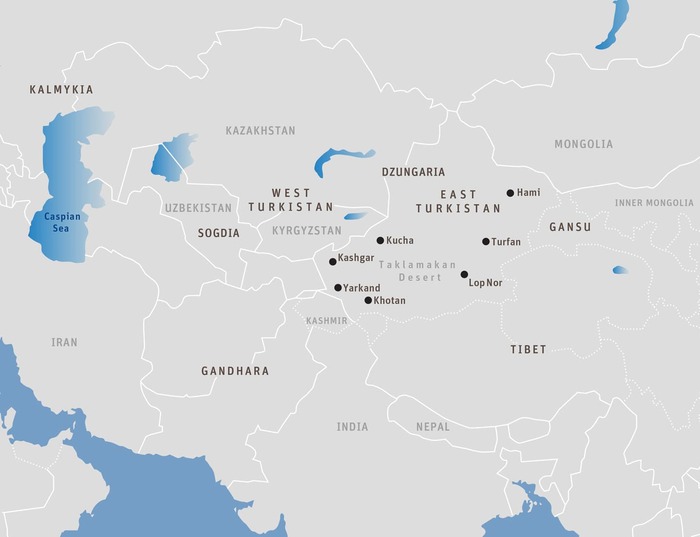Khotan and the Southern Rim of the Taklamakan Desert
East Turkistan (Chin. Xinjiang) has a long history of Buddhism. Along the southern rim of the Taklamakan Desert, Buddhism came to Khotan from India in the 1st century BCE. The Khotanese were an Iranian people. With the emergence of Mahayana several centuries later in India, Khotan soon became a center of Mahayana Buddhism.
Around the 1st century CE, Buddhism came from Gandhara (Pakistan) and Kashmir to Kashgar, and also from Gandhara, Kashmir, and Khotan to the Indo-European people of Kroraina, near Lop Nor to the east of Khotan. Kroraina was abandoned to the desert in the 4th century and most of its people joined Khotan.

The Tocharians and the Northern Rim of the Taklamakan Desert
Along the northern rim of the desert, the Tocharian people brought Buddhism to Kucha and Turfan in the 2nd century CE.
The Tocharians were the descendents of the Yuezhi, a Caucasian people who spoke an ancient western Indo-European language and represented the easternnmost migration of the Caucasian race. According to some sources, a group of Yuezhi had migrated to present day eastern Kazakhstan and eventually to present day Afghanistan and Tajikistan. There, they also became known as the Tocharians and adopted Sarvastivadin form of Hinayana Buddhism. The Tocharians of Kucha and Turfan also followed Sarvastivada.
Although most of the Uighurs, a Turkic people, came from the Altai Mountain region of Tuva, to the north of Western Mongolia, one small branch lived in Turfan from the 4th century and followed Tocharian Buddhism.
Chinese and Sogdian Settlers
The Chinese had military garrisons in these oasis states from the 1st century BCE until the 2nd century CE, but this was before the establishment of Buddhism in China. Chinese Buddhist influences came in the centuries that followed, from Chinese merchants traveling and settling along these two branches of the Silk Route. Sogdian Buddhist merchants from Uzbekistan also settled in these oasis cities, especially along the northern route, and influenced the development of Buddhism as well. Like the Khotanese, the Sogdians were an Iranian people.
The Tibetan Connection
The Tibetans ruled all the East Turkistani oasis states except Kashgar and Yarkand, as well as most of Gansu and eastern Kyrgyzstan, from the early 7th until the mid-9th centuries, with a break in the middle when they were taken by the Chinese. Archeological evidence indicates only a small influence on the region by the Tibetans, but this must be investigated further. The Tibetans, on the other hand, borrowed a great deal from Khotan – especially the alphabet and of translating Buddhist technical terms. It was the Khotanese script that Tonmi Sambhota learned in Kashmir and adapted for writing Tibetan. The Khotanese script derived from an Indian one, but like Tibetan, uses an 'a-chung for transcribing long Sanskrit vowels and puts its own vowels at the end of the alphabet.
The Uighurs
In the mid-9th century, at about the same time as the Tibetans left East Turkistan after Langdarma's rule, most of the Altai branch of the Uighurs, who had been ruling Mongolia for the previous century and a half, moved to Turfan. They had lost Mongolia to the invading Altai branch of the Kyrgyz and, once in Turfan, founded the Qocho kingdom, which ruled the entire northern rim of the desert, from Kucha to Hami, and the eastern part of the southern rim, around Lop Nor. The Mongolian Uighurs, as they are now called, abandoned their Manichaean religion and adopted the Buddhism of their Turfan relatives. Several scholars, however, believe that before they left Mongolia, some Uighurs were already Buddhists, due to contact with the Sogdian Buddhist merchants and from the remaining influence of the Buddhist Turks who ruled Mongolia before them.
The Qarakhanids
After the Tibetans left East Turkistan in the mid-9th century, Khotan became independent, and continued its Buddhism. The local Turkic people around Kashgar established the Qarakhanid kingdom, which initially encompassed Kashgar as well as eastern Kyrgyzstan and Kazakhstan. Some scholars believe that these Turkic people were another branch of the Mongolian Uighurs that migrated there as well. For a century, the Qarakhanids followed a mixed Kashgari Buddhist and shamanist religion.
The Qarakhanids were the first to become Muslim, and this was at the end of the 10th century. After a long period of war, they defeated Khotan in the mid-12th century and converted it to Islam. Tibetan troops fought on the side of their fellow Buddhists of Khotan during these wars. The Uighurs of Qocho, however, continued to be Buddhist. They not only gave their writing system, which they had adopted from the Sogdians, to the Mongols under Chinggis Khan, but were the first to introduce Buddhism to the Mongols. When the Mongols later adopted Tibetan Buddhism, the Uighurs adopted it also. Islam came to the Uighurs from the 14th to the 17th centuries, spreading slowly from west to east.
The Dzungar and Kalmyk Mongols
The Dzungar Mongols maintained Tibetan Buddhism in northern East Turkistan and eastern Kazakhstan from the late 16th century until they were defeated and almost entirely exterminated by the Manchus in the mid-18th century. The Kalmyk Mongols broke off from the Dzungars in the early 17th century to move to the Volga region of European Russia. One part of them returned to northern East Turkistan at the end of the 18th century and has been living there ever since, following Tibetan Buddhism. Before the present influx of Han and Hui Chinese immigrants, however, the vast majority of the East Turkistan population consisted of Uighurs, following Islam.